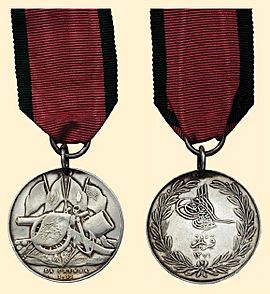Turkish Crimea Medal facts for kids
Quick facts for kids Turkish Crimea Medal |
|
|---|---|

Turkish Crimean War Medal reverse (left) and obverse, Sardinian issue
|
|
| Type | Campaign medal |
| Eligibility | British, French, and Sardinian personnel |
| Campaign(s) | Crimean War |
| Description | Silver disc, 36mm in diameter |
| Statistics | |
| Established | 1856 |
Ribbon bar of the medal |
|
The Turkish Crimea Medal (Turkish: Kırım Harbi Madalyası) is a special award given by Sultan Abdulmejid I of the Ottoman Empire. It was given to soldiers from Britain, France, and Sardinia who fought alongside the Ottoman Empire in the Crimean War (1854–1856). This medal was only for those who survived the war. A famous photographer named James Robertson helped design it. British soldiers who received this medal also often got the British Crimea Medal.
Contents
What the Medal Looks Like
The Turkish Crimea Medal is made of silver and is about 36 millimeters (1.4 inches) wide. It has two main sides: the front (obverse) and the back (reverse).
The Front of the Medal
The front of every medal shows the Sultan’s tughra. A tughra is like a special signature or seal used by Ottoman sultans. It also shows the Muslim calendar year 1271.
The Back of the Medal
The back of the medal tells a story about the war. It shows a cannon, which is a large gun, on top of the Russian flag. There is also an anchor and a mortar, which is another type of cannon.
Behind these, you can see the flags of the four allied countries:
- The Turkish flag is always on the left.
- The other three flags show which country the medal was made for. The flag in the middle on the right side, above the anchor, identifies the country.
- For British medals, it's the Union Flag.
- For French medals, it's the tricolour flag.
- For Sardinian medals, it's the flag of the Kingdom of Sardinia. This flag looks like the Italian tricolour but has the Savoy shield in the middle.
At the very bottom of the medal, there's an inscription that says "Crimea 1855." However, the exact wording changes slightly depending on the country:
- "Crimea 1855" for British medals.
- "La Crimee 1855" for French medals.
- "La Crimea 1855" for Sardinian medals.
Why Some Medals Were Different
About 22,000 medals meant for British soldiers were lost in a shipwreck. Because of this, many British soldiers ended up receiving medals that were originally made for Sardinian or French troops. The Sardinian version was the most common one given out instead.
How People Wore the Medal
Many people mistakenly thought the side with the flags and cannon was the front of the medal. They often wore it that way. However, the side with the Sultan's tughra is actually the correct front. Even today, many collectors still display the medal with the flags and cannon facing forward.
Quality of the Medals
The medals were not always made very well. Some British officers had better quality copies made from real silver. These copies often looked clearer and were heavier. The British versions of the medal are also thought to have had a bit more silver in them than the French or Sardinian ones.
The Ribbon
The medal hangs from a ribbon that is dark red with green edges. The original ribbons were quite narrow. However, when given to British soldiers, these ribbons were usually replaced with wider ones that matched the standard British medal ribbons. The medal was originally held by small steel rings, but these often rusted. So, soldiers often changed them to different types of hangers to fit the wider ribbons.
Naming on Medals
The Turkish Crimea Medal was usually given out without a name on it. However, some soldiers had their names engraved on their medals privately, in different styles.
Who Received the Medal
Sultan Abdulmejid I offered the medal to all three of Turkey's allies. But each country decided how many medals to accept and who would receive them.
United Kingdom
The United Kingdom accepted 74,000 medals for all ranks of the Army who had also earned the British Crimea Medal and survived the war. Another 25,000 medals went to the Royal Navy. Queen Victoria allowed British soldiers to wear this medal on their uniforms.
France
France only ordered 1,500 medals for their troops who had served in Turkey. The French commander in the Crimea, Marshal Pélissier, thought the medals were poorly made and "not very attractive." Unlike the British, France did not officially allow their soldiers to wear the Turkish Crimea Medal on their uniforms.
Sardinia
Sardinia accepted 5,000 Turkish medals. These were given to specific officers and soldiers who had shown great bravery or skill during the campaign.
It's important to remember that because many British soldiers received Sardinian or French medals, the number of medals each country received doesn't tell us how many of each design were actually given out.
See also

